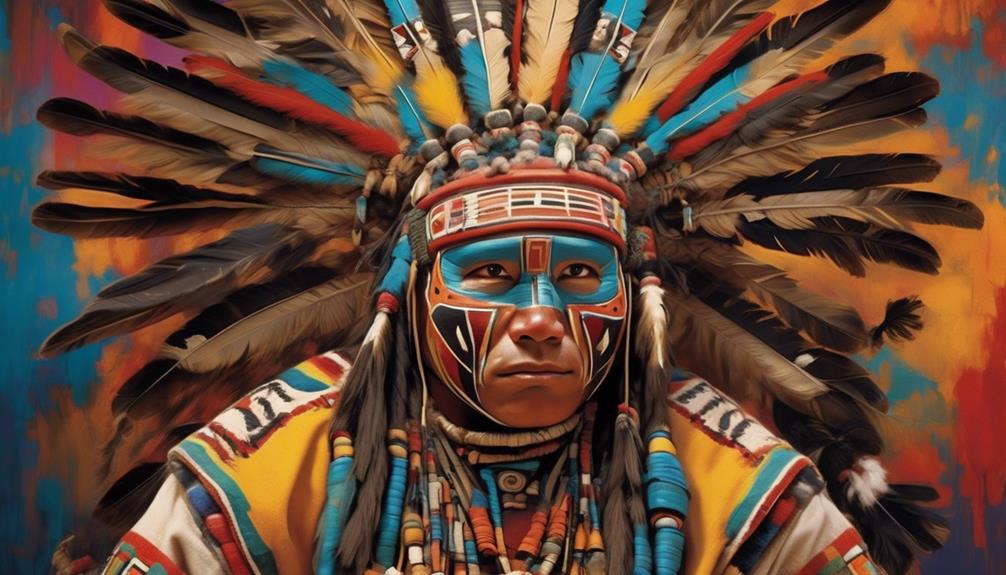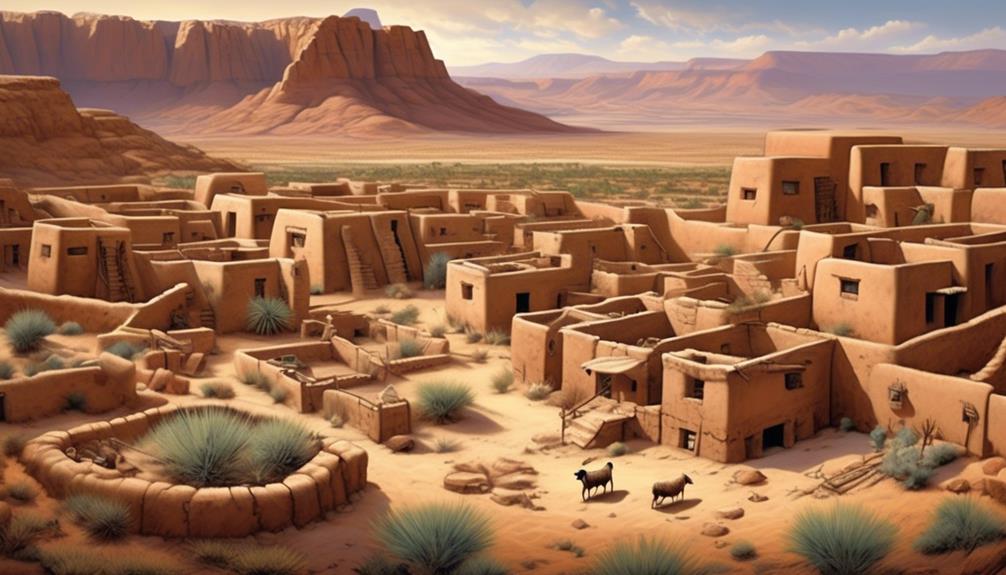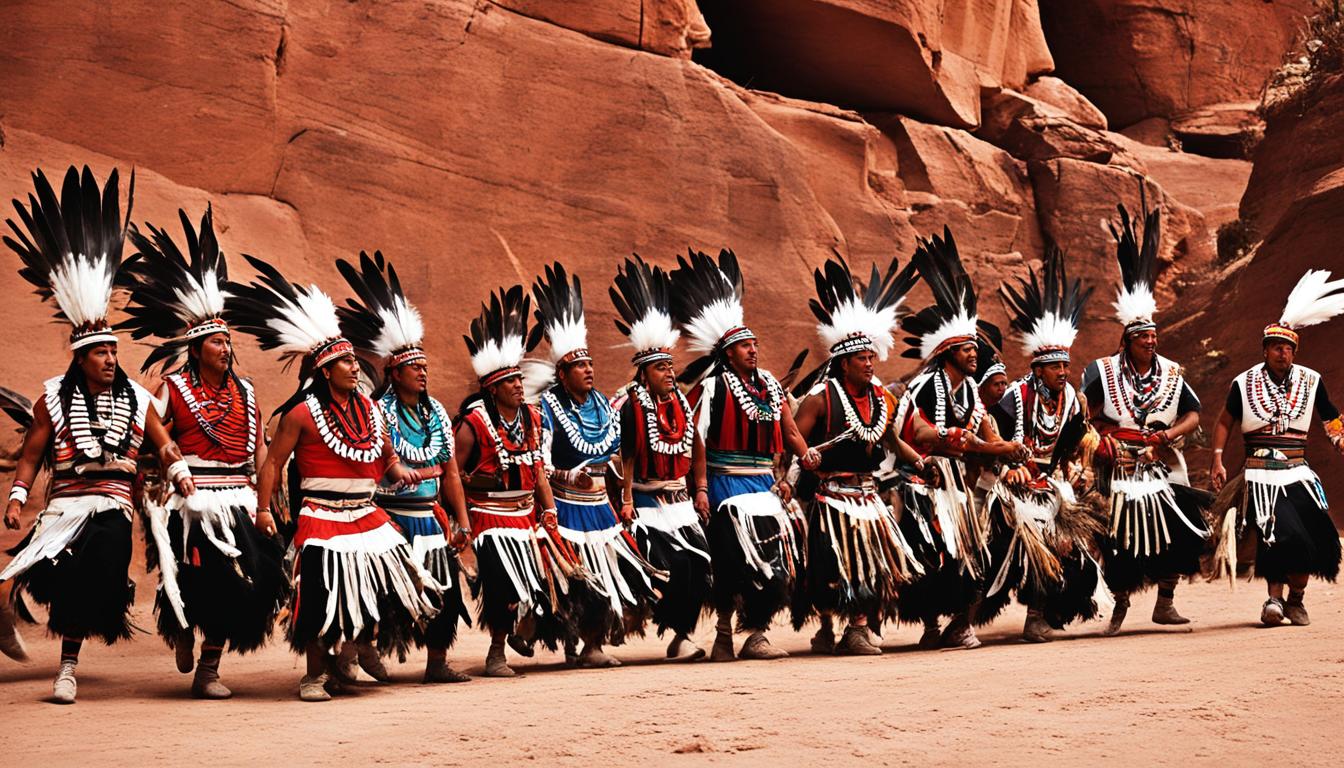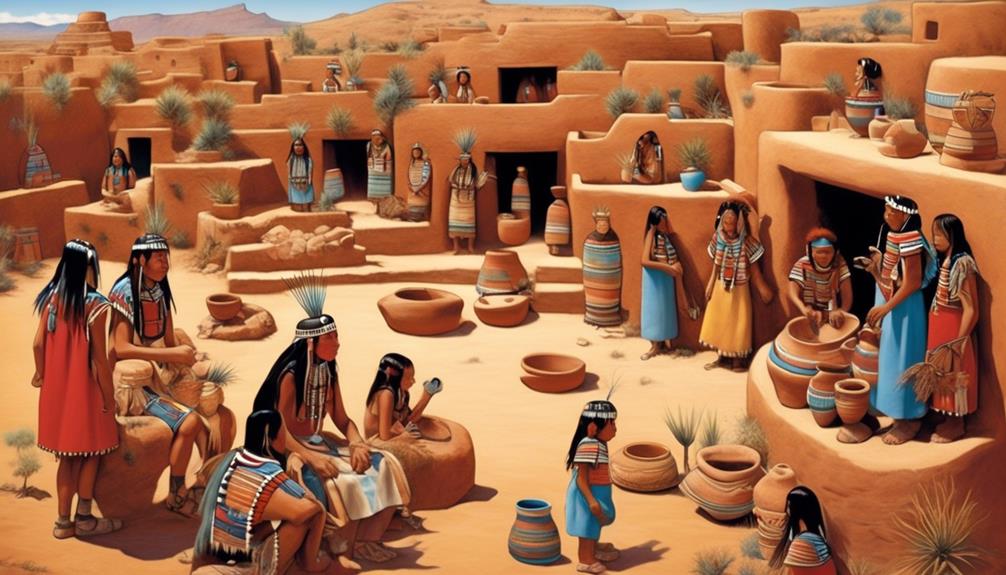Within the intricate web of Native American customs, the Hopi tribe is well-known for their abundance of ancient knowledge and ceremonial rituals.
From their intricate dances to their symbolic rituals, the Hopi people have long been revered for their deeply spiritual ceremonies.
But what exactly are these special ceremonies, and how do they contribute to the cultural heritage of the Hopi tribe?
Join us as we explore the fascinating world of Hopi traditions and uncover the significance of their unique rituals, shedding light on their historical and contemporary significance.
Key Takeaways
- Hopi ceremonies preserve cultural heritage and maintain a spiritual connection to ancestors.
- Seasonal ceremonies mark the passage of time and honor the interconnectedness of all living things.
- Healing rituals restore balance and well-being to individuals and the community.
- Traditional dances symbolize the connection to the land, ancestors, and the divine.
The Importance of Hopi Ceremonies
The Hopi ceremonies play a crucial role in preserving the tribe's cultural heritage and maintaining a spiritual connection to their ancestors. These ceremonies hold immense spiritual significance for the Hopi people and are deeply intertwined with their beliefs, traditions, and way of life. The rituals and practices carried out during these ceremonies are believed to ensure the well-being of the community, the fertility of the land, and the balance of the natural world.
Community participation is integral to the significance of these ceremonies. The entire tribe comes together to partake in these sacred rituals, fostering a sense of unity and shared purpose. Through active involvement in these ceremonies, knowledge and traditions are passed down from one generation to the next, strengthening the fabric of the community.
The spiritual significance of the ceremonies is evident in the reverence and respect with which they're approached. The Hopi people view these ceremonies as a direct link to their ancestors and the divine, underscoring the profound impact these traditions have on the spiritual and cultural identity of the tribe.
Seasonal Ceremonies and Rituals
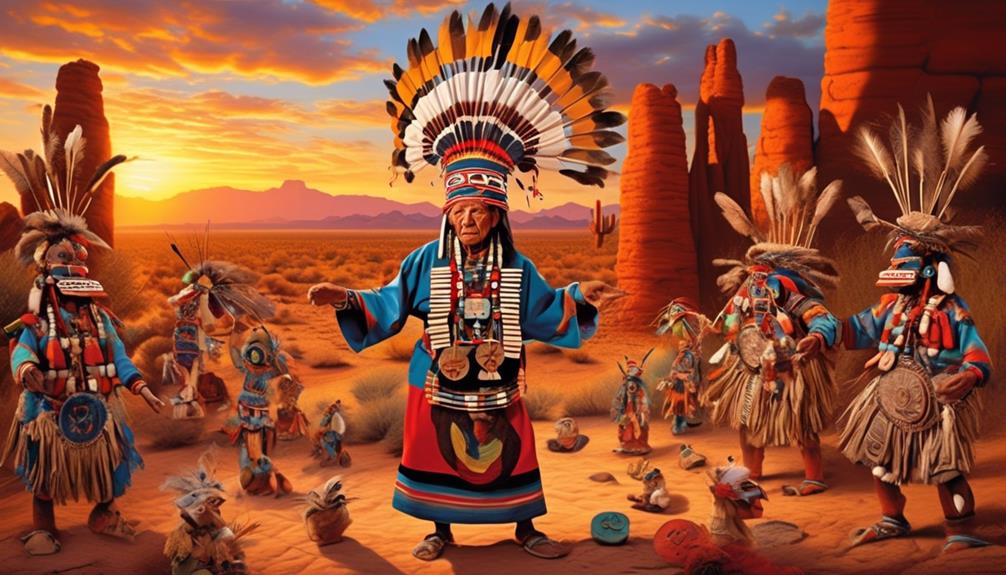
Seasonal ceremonies and rituals play a vital role in the preservation and continuation of the Hopi tribe's cultural heritage and spiritual connections, fostering a deeper understanding of their ancestral traditions and beliefs. These ceremonies hold immense cultural significance as they're rooted in the tribe's traditional practices, marking the passage of time and honoring the interconnectedness of all living things. The Hopi people deeply value the spiritual connection that these ceremonies provide, as they're seen as essential for maintaining harmony and balance within the community and the natural world.
Throughout the year, the Hopi tribe gathers for various seasonal ceremonies, each with its unique rituals and symbolism. These community gatherings serve as a time for collective reflection, prayer, and the expression of gratitude for the blessings bestowed upon them. Additionally, these ceremonies provide an opportunity for the passing down of oral histories, traditional songs, and ceremonial practices from one generation to the next, ensuring the continuity of their cultural heritage.
The seasonal ceremonies and rituals not only serve as a reminder of the tribe's profound spiritual beliefs but also strengthen the bonds within the community, fostering a sense of unity and shared purpose.
Ceremonies for Healing and Harmony
With a deep reverence for our ancestral traditions, the Hopi tribe conducts ceremonies for healing and harmony, embodying the interconnectedness of all living beings. Healing rituals are central to our cultural practices, aiming to restore balance and well-being to individuals and the community as a whole.
These rituals often involve the guidance of spiritual leaders who facilitate the connection between the physical, mental, and spiritual realms. Through the use of traditional herbs, prayers, and sacred songs, these ceremonies seek to address ailments of the body, mind, and spirit.
The Hopi people believe that spiritual harmony is essential for maintaining a healthy and thriving community, and these healing ceremonies play a vital role in achieving and preserving such harmony.
Our healing rituals are deeply rooted in the understanding that the well-being of individuals is intricately linked to the well-being of the community and the natural world. By addressing the spiritual and emotional aspects of illness, these ceremonies not only aim to heal the individual but also to restore harmony within the community.
This holistic approach to healing reflects the Hopi tribe's profound respect for the interconnectedness of all life and the belief that balance and harmony are essential for the overall health and prosperity of the community.
Ceremonial Dances and Music
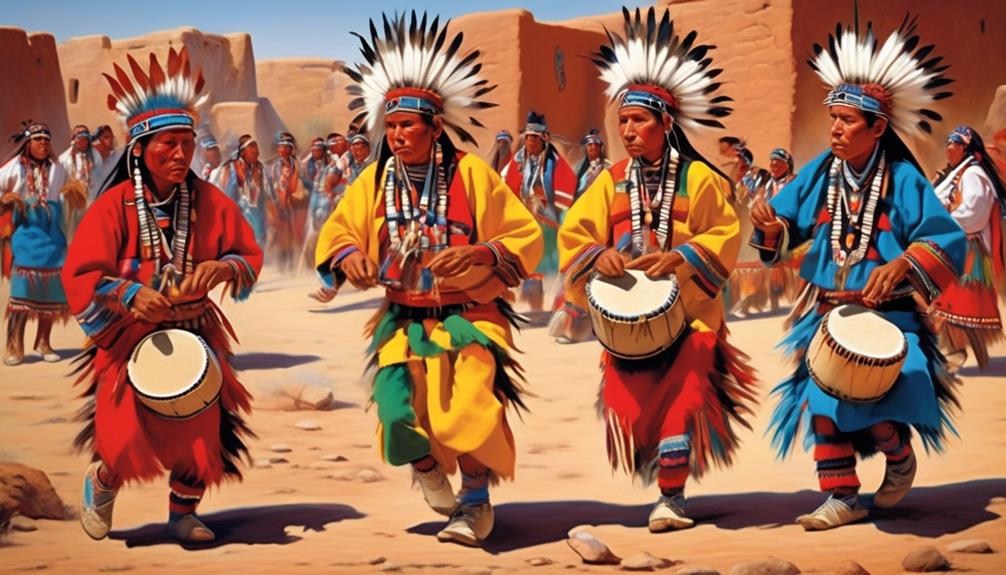
Ceremonial dances and music hold a significant place within the cultural fabric of the Hopi tribe, serving as vibrant expressions of our traditions and spiritual connection. Traditional dances are integral to our ceremonies, symbolizing our deep-rooted connection to the land, our ancestors, and the divine. These dances often depict stories of creation, migration, and the natural world, carrying profound meanings that are passed down through generations.
The sacred music that accompanies these dances is equally essential, as it sets the rhythm and tone for the ceremonial proceedings. The melodic tunes, often performed with traditional instruments such as rattles and drums, create an immersive atmosphere that invokes spiritual energy and communal harmony. Through these ceremonial dances and music, we honor our heritage, seek blessings from the spiritual realm, and reinforce the bonds within our community.
Furthermore, these traditions aren't mere performances but are deeply intertwined with our spiritual beliefs, serving as conduits for connecting with the divine forces that govern our universe. The ceremonial dances and sacred music encapsulate the essence of our cultural identity, preserving our heritage and sustaining the spiritual vitality of the Hopi tribe.
Modern-Day Significance of Hopi Ceremonies
In our contemporary society, the Hopi ceremonies continue to hold profound significance, serving as vital conduits for preserving our cultural heritage and fostering spiritual interconnectedness. The modern-day relevance of Hopi ceremonies is evident in several ways:
- Cultural Preservation: Hopi ceremonies play a crucial role in preserving traditional practices, oral history, and spiritual beliefs, ensuring that these essential aspects of our heritage are passed down to future generations.
- Community Cohesion: These ceremonies bring the Hopi community together, fostering a sense of unity, belonging, and shared identity, which is particularly important in the face of modern challenges and changes.
- Spiritual Connection: The ceremonies provide a means for individuals to connect with their spirituality, the natural world, and the divine, offering guidance and a sense of purpose in today's fast-paced world.
- Healing and Well-being: Many Hopi ceremonies incorporate elements aimed at promoting healing and well-being, addressing the physical, mental, and emotional needs of community members.
- Education and Awareness: These ceremonies serve as educational platforms, raising awareness about Hopi culture, traditions, and values, not only within the community but also among outsiders, promoting understanding and respect.
Frequently Asked Questions
What Specific Materials Are Used in Hopi Ceremonial Rituals?
Traditional materials such as corn, feathers, and cotton are used in Hopi ceremonial rituals. Symbolic objects like prayer sticks, masks, and kachina dolls are also integral to these rituals.
These materials and objects hold deep spiritual significance for the Hopi tribe and are used to honor their ancestors, connect with their deities, and maintain the balance of the natural world.
These ceremonial practices are a vital part of preserving the tribe's cultural heritage.
How Are the Leaders of Hopi Ceremonies Chosen and Trained?
Leadership selection in Hopi ceremonies involves a rigorous process. Candidates demonstrate their knowledge of traditions, values, and rituals. Training encompasses learning ancient chants, dances, and the significance of symbols.
Mentored by experienced leaders, they inherit the responsibility of preserving and passing down sacred knowledge. The community deeply respects these leaders, recognizing their vital role in maintaining the tribe's spiritual and cultural heritage.
Are There Any Restrictions or Guidelines for Outsiders Who Want to Witness Hopi Ceremonies?
Outsider participation in Hopi ceremonies is limited and guided by cultural sensitivity. It's important to understand the significance of these ceremonies to the Hopi tribe and to approach any desire to witness them with deep respect and understanding.
Due to the sacred nature of these rituals, there are specific guidelines and restrictions in place for outsiders. These are intended to honor the traditions and protect the sanctity of the ceremonies.
How Do Hopi Ceremonies Incorporate Traditional Storytelling and Oral Histories?
Traditional storytelling and oral histories play a pivotal role in Hopi ceremonies. Weaving through the fabric of our rituals, these narratives connect us to our ancestors and the natural world.
Through vivid imagery and poetic language, our stories pass down wisdom and cultural traditions. They add depth and meaning to our ceremonies, ensuring that our heritage endures through the ages.
What Role Do Women Play in Hopi Ceremonial Practices?
Women's participation in Hopi ceremonial practices holds immense cultural significance. They play integral roles in various ceremonies, such as the Butterfly Dance and the Bean Dance, symbolizing fertility and growth.
Their involvement in the preparation of ritual items and the passing down of traditional knowledge highlights their crucial contribution to preserving the tribe's customs.
This active participation underscores the vital role women play in upholding and transmitting the tribe's cultural heritage.
Conclusion
In conclusion, the Hopi tribe's special ceremonies are an integral part of their cultural identity, connecting them to their ancestors and the natural world.
From seasonal rituals to healing ceremonies, the traditions of dance and music continue to hold great significance in modern times.
The juxtaposition of ancient traditions alongside modern life highlights the enduring importance of these sacred rituals for the Hopi people.
Mary is a passionate writer who brings creativity and a fresh perspective to our team. Her words have the power to captivate and inspire, making her an essential contributor to our content. Mary’s commitment to storytelling and dedication to promoting Indigenous culture ensures that her work touches the hearts of our readers. We’re fortunate to have her as part of our team.
